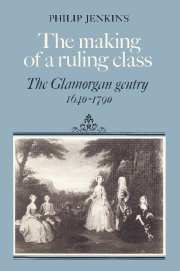Book contents
- Front matter
- Contents
- List of maps and tables
- Acknowledgments
- Abbreviations
- General introduction
- PART I SOCIAL AND ECONOMIC STRUCTURE
- PART II LOCAL AND NATIONAL POLITICS
- Introduction
- 4 Law and order
- 5 Political history 1640 – 1688: the heroic age
- 6 Political history 1688 – 1790: the new order
- Conclusion to Part II
- PART III SOCIETY AND CULTURE
- Conclusion to Part III: ‘conspicuous antiquity’
- Aftermath: towards the Victorian world
- Conclusion: from Civil War to Industrial Revolution
- Appendix 1 Parliamentary service by Glamorgan landowners 1640 – 1800
- Appendix 2 The ‘secondary’ gentry families
- Appendix 3 The ‘tertiary’ families
- Appendix 4 The Mansell family and their connections with the greater gentry
- Appendix 5 The roundhead and puritan family links of the Thomases of Wenvoe
- Notes
- Index
Conclusion to Part II
Published online by Cambridge University Press: 22 September 2009
- Front matter
- Contents
- List of maps and tables
- Acknowledgments
- Abbreviations
- General introduction
- PART I SOCIAL AND ECONOMIC STRUCTURE
- PART II LOCAL AND NATIONAL POLITICS
- Introduction
- 4 Law and order
- 5 Political history 1640 – 1688: the heroic age
- 6 Political history 1688 – 1790: the new order
- Conclusion to Part II
- PART III SOCIETY AND CULTURE
- Conclusion to Part III: ‘conspicuous antiquity’
- Aftermath: towards the Victorian world
- Conclusion: from Civil War to Industrial Revolution
- Appendix 1 Parliamentary service by Glamorgan landowners 1640 – 1800
- Appendix 2 The ‘secondary’ gentry families
- Appendix 3 The ‘tertiary’ families
- Appendix 4 The Mansell family and their connections with the greater gentry
- Appendix 5 The roundhead and puritan family links of the Thomases of Wenvoe
- Notes
- Index
Summary
In the latter part of the eighteenth century, the gentry found themselves facing a new range of political challenges. What was especially disturbing was that social conflict was also increasing even in those areas little touched by industrialisation, in the gentry heartland of the Vale. Possibly, this was partly resistance to the new county community, which was felt to have abandoned local beliefs and loyalties. Lower-class resistance to this ‘desertion’ did not express itself in forms as direct as those of the 1650s. It was rather to be seen in the new types of crime and riot, the spread of popular methodism (rampant by the 1780s), and the new assertiveness about Welsh linguistic and cultural traditions which – at least by implication – the ruling class had betrayed.
At the end of our period, rulers and ruled represented two worlds of life and thought, religion and language – in the most literal sense, ‘two nations’. Taking into account the new dangers from dissenters, jacobins and middle-class reformers, it is scarcely surprising that the gentry saw themselves as in peril; nor that their response was that ‘Great Reaction’ which lasted from the 1790s to the 1830s. I wish to suggest that the landed classes were very fortunate in achieving political stability during the early eighteenth century; but it was exactly the means by which this was achieved which contributed to the very divisive nature of politics at the end of that century.
Information
- Type
- Chapter
- Information
- The Making of a Ruling ClassThe Glamorgan Gentry 1640–1790, pp. 189 - 190Publisher: Cambridge University PressPrint publication year: 1983
